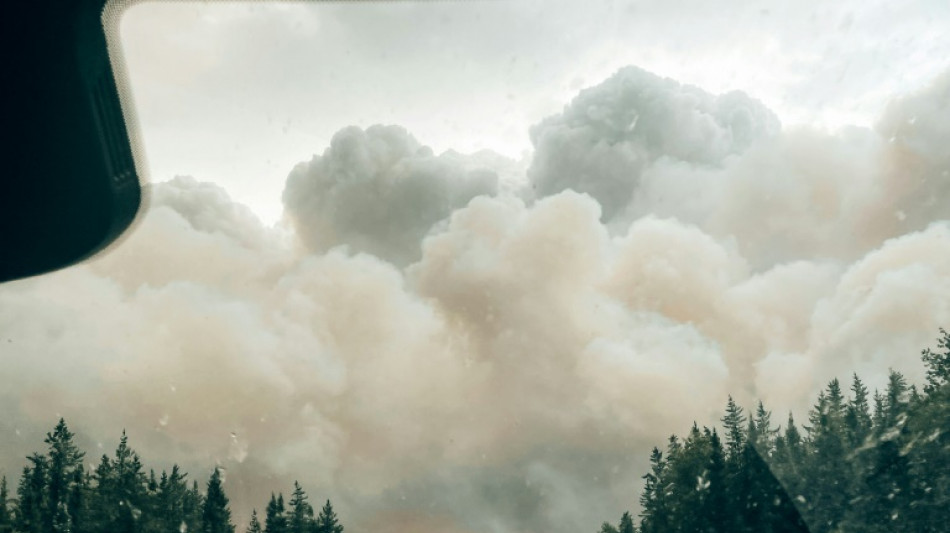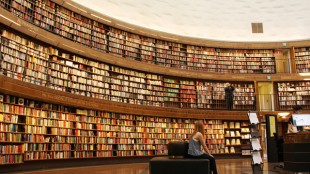
-
 Asian markets rise on lingering trader optimism
Asian markets rise on lingering trader optimism
-
Afghanistan quake kills 20, injures over 300: health ministry

-
 India hails maiden women's World Cup cricket title as game-changer
India hails maiden women's World Cup cricket title as game-changer
-
As clock ticks down, Greece tries to clean up its act on waste

-
 Local fabrics, fibres shine at eco-centred Lagos Fashion Week
Local fabrics, fibres shine at eco-centred Lagos Fashion Week
-
Spalletti bidding to revive Juve and reputation ahead of Sporting visit in Champions League

-
 Tanzania president to be inaugurated as opposition says hundreds dead
Tanzania president to be inaugurated as opposition says hundreds dead
-
Bouanga brace as LAFC beats Austin 4-1 to advance in MLS Cup playoffs

-
 'Golden age': Japan hails Yamamoto, Ohtani after Dodgers triumph
'Golden age': Japan hails Yamamoto, Ohtani after Dodgers triumph
-
Thunder roll over Pelicans to remain NBA's lone unbeaten team

-
 Hong Kong legislature now an 'echo chamber', four years after shake-up
Hong Kong legislature now an 'echo chamber', four years after shake-up
-
Most Asian markets rise on lingering trader optimism

-
 Andrew to lose his last military rank: defence minister
Andrew to lose his last military rank: defence minister
-
Trump's global tariffs to face challenge before Supreme Court

-
 Barnstorming Bayern face acid test at reigning champions PSG
Barnstorming Bayern face acid test at reigning champions PSG
-
Alonso shaping new Real Madrid on Liverpool return

-
 Half Yours favourite at Australia's 'race that stops a nation'
Half Yours favourite at Australia's 'race that stops a nation'
-
Tonga rugby league star has surgery after 'seizure' against NZ

-
 Trent's return with Real Madrid reminds Liverpool of what they are missing
Trent's return with Real Madrid reminds Liverpool of what they are missing
-
Tehran toy museum brings old childhood memories to life

-
 Iran banking on Iraq vote to retain regional influence
Iran banking on Iraq vote to retain regional influence
-
Daughter of 'underground' pastor urges China for his release

-
 Trump the Great? President steps up power moves
Trump the Great? President steps up power moves
-
Fire ravages French monastery dubbed 'Notre-Dame of the Ardennes'

-
 Bills outlast Chiefs while NFL-best Colts fall to Steelers
Bills outlast Chiefs while NFL-best Colts fall to Steelers
-
NBA champion Thunder roll over Pelicans to remain unbeaten

-
 Guardian Metal Resources PLC Announces Board Changes
Guardian Metal Resources PLC Announces Board Changes
-
Eliud Kipchoge unveils plan to run 7 marathons on 7 continents

-
 Milan deny Roma top spot in Serie A, Inter beat Verona
Milan deny Roma top spot in Serie A, Inter beat Verona
-
Lens back up to third in Ligue 1 as Lyon held at Brest

-
 NFL-best Colts fall to Steelers, Packers lose to Carolina
NFL-best Colts fall to Steelers, Packers lose to Carolina
-
'Regretting You' wins spooky slow N. American box office

-
 'Just the beginning' as India lift first Women's World Cup
'Just the beginning' as India lift first Women's World Cup
-
Will Still sacked by struggling Southampton

-
 Malinin wins Skate Canada crown with stunning free skate
Malinin wins Skate Canada crown with stunning free skate
-
Barca beat Elche to recover from Clasico loss

-
 Jamaica deaths at 28 as Caribbean reels from colossal hurricane
Jamaica deaths at 28 as Caribbean reels from colossal hurricane
-
Verma and Sharma power India to first Women's World Cup triumph

-
 Auger-Aliassime out of Metz Open despite not yet securing ATP Finals spot
Auger-Aliassime out of Metz Open despite not yet securing ATP Finals spot
-
Haaland fires Man City up to second in Premier League

-
 Sinner says staying world number one 'not only in my hands'
Sinner says staying world number one 'not only in my hands'
-
Ready for it? Swifties swarm German museum to see Ophelia painting

-
 Pope denounces violence in Sudan, renews call for ceasefire
Pope denounces violence in Sudan, renews call for ceasefire
-
Kipruto, Obiri seal Kenyan double at New York Marathon

-
 OPEC+ further hikes oil output
OPEC+ further hikes oil output
-
Sinner returns to world number one with Paris Masters win

-
 Sinner wins Paris Masters, reclaims world No. 1 ranking
Sinner wins Paris Masters, reclaims world No. 1 ranking
-
Nuno celebrates first win as West Ham boss

-
 Obiri powers to New York Marathon win
Obiri powers to New York Marathon win
-
Two Louvre heist suspects a couple with children: prosecutor


Extreme fire: 'unprecedented risk' poorly understood
In an era of town-torching megablazes spewing smoke plumes visible from space, scientists say there is still a lot they don't know about the effects of extreme fire on people, nature and the climate.
Athens, Maui and now Los Angeles are among major cities across the globe to suffer catastrophic fires, while blazes in Canada's forests have broken records in recent years.
Changes in fire behaviour wrought by climate change and other human influences represent "an unprecedented risk that is still very poorly understood", an international group of scientists warned last year in a report for the European Space Agency and FutureEarth.
Human activities, they said, "have become an inexhaustible source of wildfires".
Scientists tallying effects on people and planet are flying planes through smoke belched by raging infernos, scouring satellite images and scooping samples from soils and waterways.
Sometimes the flames come to them.
In late December 2021, Christine Wiedinmyer, a University of Colorado professor specialising in air pollution and fire emissions, was working at home when emergency services rang telling her to leave.
What started as two small fires on the edges of Boulder had become a monster wall of flame in under an hour, whipped by hurricane-force winds over snow-free grassland.
Wiedinmyer found it hard to believe there was a serious risk on that winter's day but the pasture around town was tinder-dry from months of drought and the fire was already bearing down with the force of a blowtorch.
"You could see the smoke plume right behind my house," she told AFP.
Wiedinmyer joined tens of thousands of locals inching out of town in heavy traffic engulfed in churning smoke and flying embers.
The next day it began to snow.
Wiedinmyer returned to a soot-smeared home and questions from neighbours: were surviving structures contaminated? If so, how could they be safely cleaned?
- Forecast fireweather-
Fire has played a role in nature for millions of years -- some species thrive on it -- and human history is entwined with the ability to tame it.
But destructive and intense megafires are now increasing, as humans shape a new combustible era that prominent fire historian Stephen Pyne has called the "Pyrocene".
"Fire has been a companion and now it's becoming our worst enemy," he said.
Tinderbox conditions -- a combination of heat, drought and strong winds often called "fire weather" -- are made more common by climate change.
But it is not the only factor.
Lightning, power lines and arson have provided a spark, while damage risk grows as homes and businesses encroach into fire-prone areas.
In some forest regions, decades of overzealous fire prevention have allowed a build-up of flammable vegetation, leading to calls to relearn indigenous fire management techniques.
Intense rainfall -- on the rise as warming alters the water cycle -- may make things worse, spurring plants to grow fast and then dry into kindling.
Research in 2021 linked melting Arctic sea ice to larger wildfires in the western United States.
With warming of two degrees Celsius -- just above the upper limit of the Paris climate deal -- and expected changes in rainfall, wildfires are projected to burn 35 percent more land, the UN's climate expert panel has said.
There are limitations to humans' ability to adapt, said Kirsten Thonicke, of Potsdam Institute for Climate Impact Research, as smoke carries pollution huge distances.
"You cannot evacuate Sydney or San Francisco, you can only try to protect people there," she said, stressing the need to cut planet-heating emissions.
- 'Regime change' -
Some fires change the weather.
Firestorm clouds can whip up winds and shoot off lightning bolts, while fire tornados are towering funnels of flame thrashing across the landscape.
And extreme blazes are affecting the environment and atmosphere.
The 2023 Canadian wildfires released more carbon in five months than Russia emitted from fossil fuels in a year, NASA scientists found.
Most of that CO2 is reabsorbed as trees regrow but there are concerns that more frequent fires could reduce forests' capacity to take up carbon.
In 2023, researchers found that a chemical reaction from smoke released by massive wildfires in Australia made 2020's ozone hole 10 percent wider.
Another study found ash from the same fires landed on the ocean, triggering plankton blooms that soaked up the extra CO2, at least temporarily.
Joan Llort, of the Barcelona Supercomputing Center, who led that research, said ash from huge fires was part of "regime change" in the Arctic, coating ice and causing it to melt faster.
- Close to home -
What preoccupied Christine Wiedinmyer after Boulder's Marshall Fire was residue in homes.
"There's a lot of nasty stuff that gets put out there when you burn a house or a car, or electronics," she said. "Where does it go?"
Wiedinmyer and colleagues took samples from the air, soils and houses and measured the effects of cleaning.
Early research found harmful smoke compounds were sucked into walls only to leach out days or even months later.
One finding of potential use to residents in LA, where thousands of homes have burned, was that wiping down walls and floors with soap and water reduced contamination.
"That is a really useful piece of information to help guide future people who are exposed," Wiedinmyer said.
A.Rodriguezv--AMWN